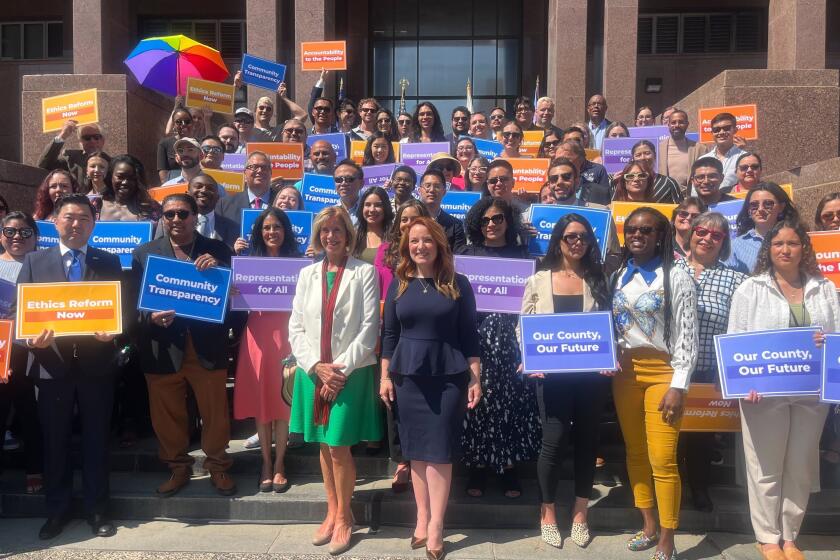Final-Hour Ad Blitz Planned for Hospital Tax
- Share via
A sweating paramedic makes an urgent radio call about the injured child he’s treating -- only to be told that the nearest hospital is closed to trauma patients. A dispatcher directs him to another hospital.
“It’s too far!” the paramedic says, as the boy’s distraught mother looks on.
The emotional scene isn’t a trailer for the next prime-time medical drama, but rather a television commercial supporting a new tax to help fund the county’s cash-starved network of trauma centers and emergency rooms.
The 30-second spot, paid for by the union representing county health-care workers, is the dramatic centerpiece of a last-minute, million-dollar ad campaign on behalf of a proposed new parcel tax for Los Angeles County residents. If approved, the tax would cost the owner of an average-sized property -- about 1,400 square feet -- $42.66 a year.
The proposal will appear on the Nov. 5 ballot as Measure B, and, if passed, would raise $168 million for the emergency and trauma-care system through a tax on developed property in the county.
Supporters say the tax is needed to save a trauma care system that has been steadily failing in recent years. Opponents counter that, while health services do need attention, a new property tax is the wrong way to pay that bill.
The county’s network of trauma hospitals, which numbered 22 in 1985, has since been pared to 13. With the county facing a health-care budget deficit of $500 million to $750 million within three years, county supervisors say further cuts will be hard to avoid.
“It’s the most compelling issue on the ballot,” said Los Angeles County Supervisor Zev Yaroslavsky, who wrote the measure. “It’s about every man, woman and child in the county -- just a traffic accident, gunshot or heart attack away from needing an emergency room.”
Opponents of the measure have no plans for an advertising campaign. Instead, they’re counting on a requirement that the new tax be approved by two-thirds of voters across the county to help defeat the measure. That requirement, imposed in 1978 by Proposition 13, historically has made it difficult to win voters’ approval for tax hikes.
“Two-thirds measures are always tough,” said Bob Stern, an expert on money and politics in California who is not involved with Measure B. “Voters are fairly conservative.”
On the other hand, Stern added: “Voters feel ... strongly about safety and health.”
With Measure B, voters will be forced to choose between their aversion to taxes and their support for improved health care.
“It needs a two-thirds vote, and therein lies a significant protection,” said Jon Coupal, president of the Howard Jarvis Taxpayer’s Assn. Coupal said the county should “reprioritize” existing spending rather than levy a new tax at a time “when taxpayers are really stretched to the limit.”
There are other hurdles facing the measure. It appears on a November ballot crowded with other attention-grabbing issues, including a host of statewide political campaigns; Valley and Hollywood secession; Measure K, a $3.3-billion bond for school construction in the Los Angeles Unified School District; and Measure A, a $250-million bond that would pay for earthquake and fire safety improvements at county-owned science and cultural institutions.
Measure B also got a late start. A divided county board of supervisors approved it for the ballot in late July, and many voters are still only dimly aware of the issue.
“It wasn’t like we had a lot of lead time to put together a coalition,” said Rick Taylor, campaign consultant for the Measure B Saves Lives Committee.
The committee’s roster includes Mayor James K. Hahn; Thomas M. Priselac, president of Cedars Sinai Medical Center; the Los Angeles Area Chamber of Commerce; the Los Angeles County Federation of Labor; and former Mayor Richard Riordan.
Still, the abbreviated campaign, Taylor said, “has made it tougher to raise money.” Of the approximately $1.5 million or so the campaign said it has raised so far, $900,000 has come from the Service Employees International Union.
About 20,000 members of Local 660 chapter work in the county health-care system, according to the union.
Private hospital groups have also contributed, concerned that further cuts in the county’s trauma and emergency room network could inundate their emergency rooms with patients.
The difficulty, supporters of the measure say, is getting average people to appreciate the scope and seriousness of the problem. To counter that, supporters of the measure are sending approximately 4 million pieces of direct mail to Los Angeles County residents.
“The target audience is middle-class Angelenos who are under the misconception that this is not for them,” Yaroslavsky said. “This is for them, make no mistake about it.”
To make that point, Yaroslavsky notes that if Microsoft founder Bill Gates were seriously injured in an auto accident on the 110 freeway near downtown, even Gates, a multibillionaire, would be taken to County-USC Medical Center for trauma care.
Los Angeles County Supervisor Mike Antonovich agreed that the trauma care system is important, but voted with Supervisor Don Knabe against placing the measure on the ballot. Antonovich called Measure B “an assault” on homeowners, people on fixed incomes and property owners.
“It’s a new property tax for non-property tax-related services,” said Antonovich. He added that the state, not the county, should rescue struggling local trauma centers.
More to Read
Sign up for Essential California
The most important California stories and recommendations in your inbox every morning.
You may occasionally receive promotional content from the Los Angeles Times.













